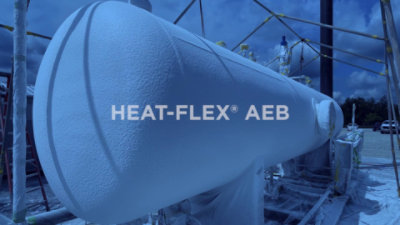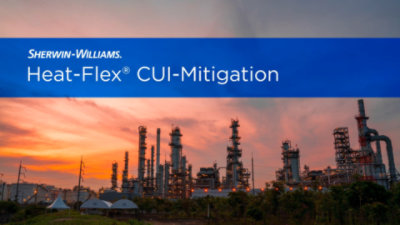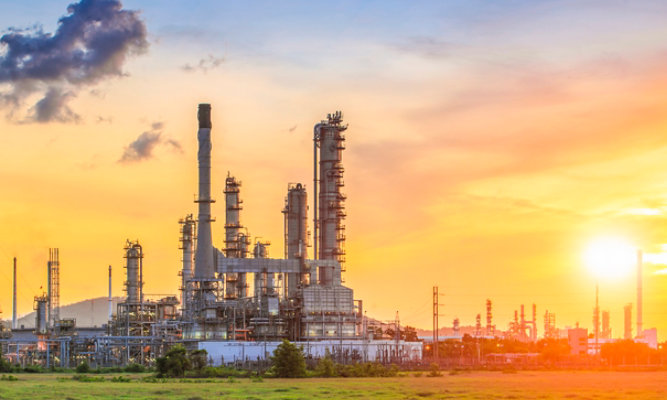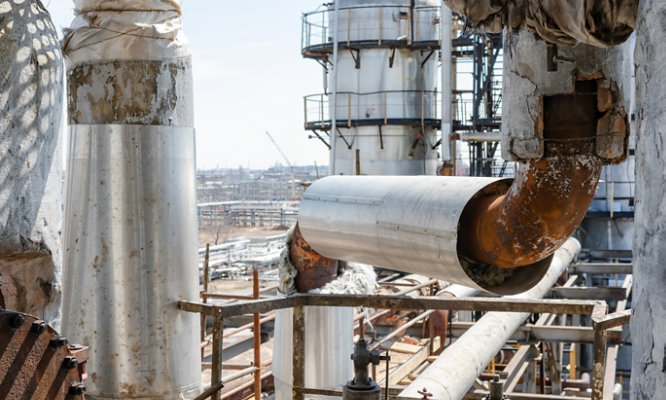Figure 5. Condensation and ice can form on the exterior of assets experiencing significant temperature differentials between their interior contents and the ambient air.
Triumphing Over Temperature Extremes and Crushing Corrosion With Coatings
How Considering Different Coatings Can Help You Make the Most of Pipeline Infrastructure Repairs
By Neil Wilds, Global Product Director – CUI, and Dr. Jeffrey Rogozinski, Global Product Director – Fusion-Bonded Epoxy/Pipe, Sherwin-Williams Protective & Marine

Many energy pipeline infrastructure assets face harsh operating conditions related to temperature extremes. For example, buried and aboveground pipelines pumping heated contents face extreme cold in northern climates and sometimes drastic temperature differentials where pipes transition from buried to exposed. Compressor stations also experience dramatic temperature fluctutions at compression points, leading to condensation forming on affected assets.
These temperature differentials create conditions that can encourage corrosion. In fact, they’re partly responsible for the repairs that are eventually required on many pipeline and compression station assets.
Condensation and other moisture on the exteriors of affected equipment can deteriorate protective coatings as it works its way down to the metal substrate where pitting corrosion can develop. This moisture can also drip onto surrounding equipment and promote corrosion there. In addition, moisture can become trapped under the traditional insulation systems that are applied to assets for thermal protection. There, it can create the potentially dangerous condition of corrosion under insulation (CUI). Further, thermal stresses and the associated material fatigue can deteriorate protective coatings.
While corrosion is certainly expected on coated assets over time, it does not have to happen rapidly. When it does, pipeline operators should take the time to investigate alternatives so they can avoid having to perform premature maintenance in the future. For pipelines, that could mean choosing different materials or adding layers of protection. On compressor station assets, it may mean removing insulation in favor of coatings that offer a similar level of thermal retention to retain process heat and mitigate condensation potential, while also eliminating CUI. Each decision offers the opportunity to extend asset service lives and thereby decrease long-term operational and environmental costs in the process.
Enhancing Pipeline Corrosion Resistance
Pipeline repair needs typically become evident via line monitoring and various inspection methods. Technicians will likely observe cathodic protection systems for early warning signs of corrosion in buried pipelines. In addition, they’ll perform periodic testing using ultrasonic devices, magnetic particle inspections and/or internal inspections with remote-operated devices. Direct visual inspection of buried pipes is not possible, but technicians can observe the exterior condition of non-insulated exposed pipes.
When such inspections reveal corrosion or the potential for it to develop, pipeline operators have a unique opportunity to improve future performance. The field history of how the coatings performed in service can serve as a baseline for decision making. If that baseline falls short of performance expectations for an asset and its operating environment, operators may want to explore other coating options.
Evidence of abrasions that cut through the fusion-bonded epoxy (FBE) coatings typically applied to pipe exteriors is a helpful example for considering alternative coatings. Such FBEs are designed to mitigate corrosion. But when the continuous coating layer is breached, exposing the metal substrate below, corrosion can run rampant — especially considering how the elevated operating temperatures of pipelines contribute to increased corrosion potential.
In this case, the pipeline operator could add additional layers of protection to provide a stratification of properties from the outermost layer to the metal substrate below (Figure 1). For example, in especially rocky soil conditions, the pipeline owner could add a durable abrasion-resistant overcoat (ARO) on top of the FBE layer that’s applied directly to the pipe surface. The resulting dual-layer FBE coating system features the base anticorrosion FBE layer to prevent pipeline corrosion and the top abrasion- resistant layer that protects the base layer from wear (Figure 2).
Perhaps the environment the pipeline is buried in is wetter than originally anticipated and is causing premature corrosion. In this case, a moisture-resistant overcoat (MRO) could be a suitable alternative to the original single-layer FBE system used. Such MROs reduce the rate of moisture ingress into the coatings, minimizing the potential for moisture to work its way down to the pipe substrate and increase the potential for coating delamination due to fundamental adhesion loss and/or cathodic disbondment.
Sometimes operators can realize both abrasion and moisture resistance in the same coating system. As an example, Pipeclad® HOT 150 Flex MRO ARO provides excellent protection against moisture, as well as corrosive and abrasive elements in the environment. It’s also rated for use on assets running at high operating temperatures.
Eliminating CUI By Default
Corrosion can also be a difficult issue on numerous assets associated with compressor stations. Atmospheric corrosion is one animal to corral, but CUI is a completely different one to manage due to it being hidden below insulation systems — with potentially no visible signs of its existence.
CUI is common, and nearly inevitable, on pipeline infrastructure assets that are covered by traditional insulation systems consisting of thick mineral-based insulation wrapped around assets with metal cladding installed on top. The systems protect personnel from burns, while also helping materials inside pipes, valves, vessels and other equipment maintain elevated temperatures. They’re also used to minimize the temperature differential between the inside and outside of heated assets to mitigate the development of condensation, which could become a source of exacerbated corrosion potential.
While highly effective at these tasks, traditional physical insulation systems are particularly prone to troublesome CUI because moisture and contaminants very often infiltrate cladded insulation systems. Once there, the moisture will never dry out, leaving it and electrolytes in constant contact with the insulated asset’s metal substrate. With the elevated heat from the covered asset present in this moist, warm environment, corrosion potential is very high. However, asset owners can help to minimize the potential for CUI by using an effective CUI-mitigation primer, such as Heat-Flex® ACE or other similar coatings with superior proven performance.
When CUI — or the conditions for it — is present, pipeline operators have a somewhat surprising option to eliminate it. They can instead opt for using a thermal insulative coating (TIC) system featuring an effective CUI-mitigation primer underneath the TIC. Such a system can deliver comparable levels of thermal performance as traditional insulation systems, with just the coating acting as athermal barrier. With this high level of insulating capacity possible in coatings, pipeline operators can, in many cases, remove physical insulation systems in favor of applying a few layers of the coating material. In doing so, they can maintain the necessary thermal performance while also eliminating CUI (Figure 3).
The potential for CUI to disappear when using TICs is realized because the coatings take the place of physical exterior insulation systems. With no physical system mounted on top of a valve, for example, there is nothing under which corrosion could form. The corrosion zone that would otherwise exist between the insulation and the substrate is gone, and CUI potential is simply eliminated by default. The only thing left to worry about is atmospheric corrosion, which is much slower to form and easier to identify compared to corrosion hidden underneath insulation systems.
Retaining Process Heat With TICs
The potential to even consider using a TIC instead of a traditional insulation system can be attributed to the coating’s ability to retain a great deal of process heat within an asset. When using a TIC like Heat-Flex® AEB, a coating layer applied at just a half- to three-quarters-inch thick can help assets maintain operating temperatures up to 350°F (177°C), with excursions to 400°F (204°C). The coating can retain process heat at levels comparable to traditional inservice mineral-based insulation systems, while eliminating the threat of CUI and reducing the need for additional resources.
A high insulation particle content within its dried coating film provides Heat-Flex AEB with this level of insulating capability. The insulation particles couple with entrapped air present in the coating’s film, acting as an effective insulator that slows the transfer of heat energy through the coating. More heat then stays within the coated asset, meaning owners don’t need to expend as much energy to heat the contents.
Owners can also reduce their heating expenditures due to the consistent thermal performance TICs offer compared to traditional insulation systems over time. As moisture finds its way beneath the cladding in a traditional system, mineral wool insulation loses some effectiveness — up to 85% of its R-value when 10% water by volume is present in the mineral wool. As the insulation’s thermal performance diminishes, pipeline operators will need to increase heating for the affected asset.
TICs don’t face the same moisture-related issues. Their closed-cell coating film structure minimizes the amount of moisture the coating can absorb. In addition, that moisture can dissipate from the coating through heating and evaporation within 24 hours. Therefore, TICs are able to maintain thermal consistency and will remain at that same level of insulating capacity throughout their service lives. That means pipeline operators can maintain assets at their required operating temperatures without needing to increase process heat over time.
Given the surprising thermal performance TICs offer, pipeline operators may be able to replace most of their traditional insulation systems with TICs during repair and maintenance cycles. That includes insulation on compressors, process piping, coolant lines and an array of other assets (Figure 4). In addition, operators can consider using TICs on sections of aboveground pipelines, depending on the thermal performance needs and ambient temperatures. Such pipeline sections are present in remote areas or regions with extreme permafrost where burying pipe underground is less feasible.
Mitigating Condensation With TICs
TICs like Heat-Flex® AEB can help to minimize the development of condensation on the exterior of assets that face extreme temperature differentials between their internal contents and the ambient air. Such temperature gaps are particularly common at compression transition points, as a gases’ temperature increases drastically when compressed and decreases rapidly as it decompresses.
Moisture forming on the surface of assets due to condensation can become a source for corrosion on the affected assets themselves, as well as any surrounding equipment. It can also lead to the formation of thick ice that completely covers valves and other components, leaving them unable to be operated (Figure 5). The insulating capabilities of a TIC help to minimize the difference between the surface temperature of an asset and the ambient air, keeping condensation and freezing to a minimum. For example, a TIC added to the exterior of aboveground pipes can help to minimize the formation of condensation on pipes where they emerge from or enter the ground. These soil-to-air interfaces are notorious for creating condensation in cold weather due to the pipe contents being much warmer than the ambient air.
Using a TIC for condensation mitigation also removes a notable contributor to CUI. When condensation occurs underneath insulation systems, it adds even more moisture to the mineral wool, diminishing the effectiveness of the insulation system and raising the potential for CUI because more moisture will be in contact with the substrate. Using a TIC instead literally removes the CUI potential while also reducing condensation.
Realizing Coast and Environmental Savings
Notable cost and environmental savings are possible when replacing traditional insulation systems with TICs. The biggest savings come from eliminating the thick mineral-based insulation, wiring, pins, banding and exterior metal cladding. All these materials add to the cost and environmental footprint of insulating hot assets. Switching to a coating as the insulator eliminates those physical materials and the hard and environmental costs of manufacturing, shipping and storing them. Additional savings are evident by eliminating CUI and therefore minimizing the amount of steel that will corrode and need to be replaced on assets over time.
Pipeline operators can also save money by eliminating complex CUI inspection protocols when switching to TICs. Technicians will no longer need to remove portions of cladding and insulation to visibly inspect the metal substrate below. Operators can then extend their inspection and maintenance intervals.
Reducing CUI Risk and Improving Asset Lives
Addressing corrosion on pipeline infrastructure assets and considering alternative options when performance is poor is critical for extending service life and reducing maintenance costs. Extreme temperature differentials can accelerate corrosion, but by using an ideal coating system for the application, operators can mitigate this risk. Advanced TICs offer a solution for insulated applications by retaining process heat and minimizing condensation while eliminating the potential for CUI. By replacing traditional insulation with TICs, operators can achieve significant cost savings, environmental benefits and enhancedasset longevity, ultimately leading to more efficient and sustainable pipeline operations.
ABOUT THE AUTHORS
Neil Wilds is Global Product Director, CUI, for Sherwin-Williams Protective & Marine. With over 30 years of technical coatings experience, Wilds develops strategies for long-term asset protection and directs the development of specifications and testing programs. He is a member of several coatings associations including AMPP, NORSOK M501, the International Organization for Standardization (ISO) and others. Contact: Neil.Wilds@sherwin.com
Dr. Jeffrey Rogozinski is Global Product Director, Fusion-Bonded Epoxy/Pipe, for Sherwin-Williams Protective & Marine. With more than 30 years of experience in coatings and academia, he is responsible for developing protective coatings, powder coatings, resins and additives for the oil and gas, pipeline, and bridge and highway markets. His coatings science emphasis is on researching and testing polymer synthesis and structure-property characterization. He is a member of several coatings associations and a consultant for global specification writing for CSA Group, ISO, ASTM International, NACE International and others. Rogozinski holds a doctorate in applied science for polymer and composite chemistry. Contact: Jeffrey.Rogozinski@sherwin.com
Figure 1. A dual-layer FBE coating system features a base anti-corrosion FBE layer to prevent pipeline corrosion with an abrasion- and moisture-resistant overcoat (ARO/MRO) applied on top that protects the base layer from wear.
Figure 2. A dual-layer ARO/MRO FBE coating system like Pipeclad® HOT 150 Flex MRO/ARO can be used to improve moisture, gouge and impact resistance on buried and exposed pipelines.
Figure 3. Using a thermal insulative coating on various assets such as process piping allows pipeline operators to remove physical insulation systems, while maintaining process heat, minimizing condensation and eliminating CUI in the process.
Figure 4. While not part of pipeline infrastructure, this heater treater is a representative example of how TICs can replace traditional insulation systems. The unit was first primed with Heat-Flex® ACE for corrosion protection (top) and then covered with the TIC Heat-Flex® Advanced Energy Barrier (middle) to lock in process heat with no physical insulation system needed. Finally, applicators topcoated the unit (bottom) for aesthetic and durability purposes.
Discover More
Industry Expertise and Innovation
See how we help customers find customized solutions for their project and application challenges.
Our Oil & Gas Expertise
Explore our industry solutions and technology to help protect your assets.
LEARN MOREProduct Lookup
Find out more about our innovative coatings for a variety of industries.
FIND A PRODUCT


